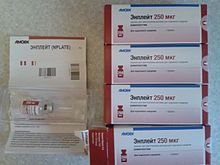Romiplostim
 | |
| Clinical data | |
|---|---|
| Trade names | Nplate |
| AHFS/Drugs.com | Monograph |
| MedlinePlus | a609008 |
| License data | |
| Routes of administration | Subcutaneous injection |
| ATC code | |
| Legal status | |
| Legal status |
|
| Pharmacokinetic data | |
| Elimination half-life | 1 to 34 days |
| Identifiers | |
| |
| CAS Number | |
| IUPHAR/BPS | |
| ChemSpider |
|
| UNII | |
| ChEMBL | |
| Chemical and physical data | |
| Formula | C2634H4086N722O790S18 |
| Molar mass | 59085.01 g·mol−1 |
| | |
Romiplostim (rINN, USAN) is a fusion protein analog of thrombopoietin, a hormone that regulates platelet production.
Indications and Marketing
The drug was developed by Amgen and is marketed under the trade name Nplate through a restricted usage program called NEXUS.[1] During development and clinical trials the drug was called AMG531.
Romiplostim is indicated as a potential treatment for chronic idiopathic (immune) thrombocytopenic purpura (ITP).[2] Romiplostim was designated an orphan drug by the U.S. Food and Drug Administration (FDA) in 2003, as the chronic ITP population in the USA is under 200,000 (the chronic adult ITP population in the USA is thought to be around 60,000, with women outnumbering men by a factor of two).[3] The wholesale cost of romiplostim if administered weekly is currently estimated at US $55,250 per year.[4]
On August 22, 2008, the FDA approved romiplostim as a long-term treatment for chronic ITP in adults who have not responded to other treatments, such as corticosteroids, intravenous immunoglobulin, Rho(D) immune globulin or splenectomy.[1][5]
Treatment regimen
Romiplostim treatment is generally administered at weekly intervals via subcutaneous injection. Prior to injection, a complete blood count (CBC) is obtained, as the dosage is dependent on the individual's body weight and platelet count at the time of treatment. The goal of treatment is to maintain the count above 50,000 per cubic millimeter (mm3) of blood, not to achieve a normal count—defined as 150,000–450,000 per mm3 in most healthy individuals. If a count of 200,000 or higher is achieved for two consecutive weeks a reduced dose is administered or treatment is suspended until the count decreases below 200,000. Discontinuation of romiplostim must be approached with great caution, as a rapid decrease in the platelet count may occur, possibly leading to bleeding diathesis.
Clinical efficacy
In well designed, 24-week, Phase III trials, romiplostim was significantly more effective than placebo in achieving the primary endpoint of a protocol-defined durable platelet response in nonsplenectomized or splenectomized adults with chronic immune thrombocytopenic purpura.[6]
Side-effects
Romiplostim's effect is to stimulate the patient's megakaryocytes to produce platelets at a more rapid than normal rate, thus overwhelming the immune system's ability to destroy them. As doing so involves changes to the bone marrow chemistry, a number of potentially serious side-effects may develop, including death, myalgia, joint and extremity discomfort, insomnia, thrombocytosis, which may lead to potentially fatal clots, and bone marrow fibrosis, the latter of which may result in an unsafe decrease in the red blood count.
References
- ^ a b Waknine, Yael (4 September 2008). "FDA Approvals: Nplate, Aloxi, Vidaza". Medscape. Retrieved 4 September 2008. Freely available with registration.
- ^ Kuter DJ, Bussel JB, Lyons RM, et al. (February 2008). "Efficacy of romiplostim in patients with chronic immune thrombocytopenic purpura: a double-blind randomised controlled trial". Lancet. 371 (9610): 395–403. doi:10.1016/S0140-6736(08)60203-2. PMID 18242413.
- ^ "Amgen to Discuss Romiplostim BLA". drugs.com. 12 March 2008. Retrieved 4 November 2008.
- ^ Perreault, S; Burzynski, J (2009). "Romiplostim: a novel thrombopoiesis-stimulating agent". Am J Health Syst Pharm. 66 (9): 817–24. doi:10.2146/ajhp080524. PMID 19386944.
- ^ "FDA Approves Nplate(TM) for Long-Term Treatment of Adult Chronic ITP" (Press release). Amgen. 22 August 2008. Retrieved 4 September 2008.
- ^ Frampton J. E., Lyseng-Williamson K. A. (2009). "Romiplostim". Drugs. 69 (3): 307–317. doi:10.2165/00003495-200969030-00006. PMID 19275274.
External links
- "Romiplostim". Drug Information Portal. U.S. National Library of Medicine.
